Now the dust has settled :), we can explore more about Jollof Rice – both a short history and the recent #Jollofgate incident.
—–00000—–
In the winter of 2010, I made wholewheat Argentine Empanadas. I served them with a fresh herb sauce, Chimichurri and got many pats on the back and one tap…one comment…from an Argentine no less which gave me an education. For life.
It is fascinating to see how everything we feel about life is (reflected) on the plate.
Take Jollof Rice for instance– its popularity is assured offline and online as these twitter hashtags suggest – #JollofGang , #JollofIsLife, #Jollofies, #Jollofnation, #Teamjollof and the most recent, most controversial #Jollofgate.
Jollof Rice. Essential to our ‘culture’. So important that West Africans at home and in diaspora will take up arms to defend anything and everything about it – its origin, preparation and by God, how it is served.
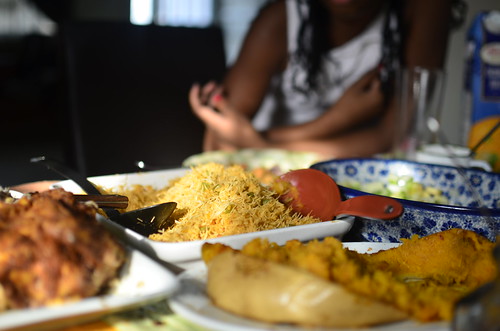
-gate
The suffix is used to embellish a noun or name to suggest the existence of a far-reaching scandal, particularly in politics and government. (And now dare I say food)
Etymology
The suffix -gate derives from the Watergate scandal of the United States in the early 1970s, which resulted in the resignation of U.S. President Richard Nixon.
The scandal was named after the Watergate complex in Washington, D.C.; the complex itself was named after the “Water Gate” area where symphony orchestra concerts were staged on the Potomac River between 1935 and 1965.
Enter #Jollofgate.
Ushered to prominence by a twist on the classic Jollof recipe on Chef Jamie Oliver’s website. The post, ‘Ghana: Jamie’s Jollof Rice Recipe’ featured a paella-looking recipe which West Africans did not take to and did not take lightly.
Though the recipe was posted in June as part of a World cup series which also featured by the way a visit to a Nigerian restaurant in Homerton, it came to ‘light’ in late October and sparked outrage from coast to coast.
As a cook who is passionate about trying out new recipes, I feel for Jamie Oliver.
As that same cook, I’ve been exactly where he is, admittedly without thousands of comments and a # to that effect.
So, in that winter of 2010 when I made Argentine Empanadas inspired by Nigerian meatpies… all was well. Well, it was till Cristina wrote me a little love note:
As an Argentinian, I feel honoured to see so many people loving our empanadas or dulce de leche, but being a native of the land, I must say that:
- Argentinian empanadas are NEVER served with “chimichurri”
- that “chimichurri” is NEVER made with fresh parsley
- that the empanada is NEVER made with whole wheat flour.
She went on…
I think each country has to defend its traditions, this is why we all have to stick to them…a macaron will never be made with all purpose flour, instead of almond, right? …a “paella” is not made with noodles, instead of rice…the same holds good for empanadas…
This said, your post is great, and your blog spectacular !!!
And therein lies the answer – cultural context. That’s what Jamie (and Jonny Garrett who wrote the piece) were missing – cultural context.
Even though Jamie did say it was his own twist on the recipe, most people were not having any of that.

The post evoked all sorts of memories and thoughts in the hearts and minds of people. I was amazed at the clarity in some of the arguments for and against the recipe. The analytics and even memes. Cracked me up…and taught me a thing or two.

Two things stand out – the look and ingredients in the dish and his idea that Jollof Rice was a ‘concept’.
Well three…the fact that ale was served with this. It just might pair well. Hmmm. Anyways, pretty dish but not Jollof.
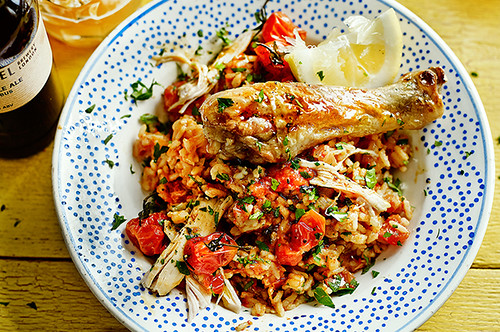
Often when we (cooks) ‘access’ recipes, our excitement to try new things experienced in glossy images on the internet or in the pages of cookbooks may blind us from the nuances that accompany that dish. The history and culture and context.
When I made the Empanadas, my creativity came to the fore. I wanted to condense all I’d learnt about Argentine cuisine in that one spree and I tried. It never occurred to me to consult with any Argentines – to share what I was doing, because you know what, I ‘owe’ them the respect.
Much of what I write and blog about puts me in ‘role model’ category. Often words in print are taken as ‘truth’ and it is my responsibility to convey the right message. So yes, there is freedom of speech and creative license in recipe development. And there is also respect and understanding of people and culture. In actually fact, there is also great opportunity to collaborate and learn, and thus ‘make authentic’.
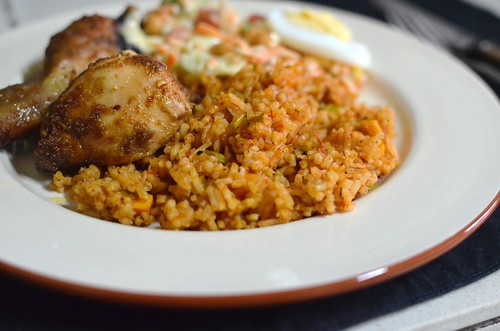
That singular response from Cristina evoked a range of emotions in me – from shame to indignation and finally, remorse.
How could I have gotten it wrong. So wrong?
Well, when I got off my high horse, I could see…easily.
I’d looked at it through my lens, coloured by my experiences – of Nigerian cuisine, of experimentation with flavor and texture. The thing is I’d never been to Argentina and so had not tried Empanadas there.
I had zero idea that my pairings were not traditional.
And one has to respect traditions whether or not you agree with them.
Truth is if I had called them meatpies inspired by Empanadas, I doubt there would have been much of a problem. What I did, out of ignorance was call them by ‘the’ name not knowing what it ‘connoted’. Well, ignorance and all, I’m glad it happened for I would never have learned how easy it was to disrespect people’s cultures and histories.
Yes, everything about life is on the plate. And yes, there are some rules that should not be broken. Well…
Ignorantia juris non excusat or ignorantia legis neminem excusat
(Latin for “ignorance of the law does not excuse” or “ignorance of the law excuses no one”) is a legal principle holding that a person who is unaware of a law may not escape liability for violating that law merely because he or she was unaware of its content.; Source
I say ‘First know all the rules, then break ‘em’.
Lessons for those who will and want to cook Jollof
A note on the commonly used ingredients
- The foundation upon which the classic Jollof rice is built is long-grain rice
- The cooked sauce which reddens it (though isn’t ‘oranges’ more appropriate) is made of blended plum tomatoes, red onions and scotch bonnet peppers of any colour
- Typical seasoning includes stock cubes (Maggi or Knorr brands), curry powder and dried thyme.
Saying all this, as a cook and Nigerian, I’ve given myself permission to make Jollof Rice however I want – with basmati or Thai Jasmine rice …if I so desire. Whether to stir-fry it, oven bake or cook it on the stove top. To combine it with noodles and to burn it. Make it smoky. How I want.
Lessons for Food writers
When writing about recipes with cultural significance, be mindful of what names you give, particularly if your methods and ingredients are not traditional – a bit of research won’t hurt.
If you don’t know, or aren’t sure – find someone who does. These days, there are so many channels to finding answers, use them.
And just in case you’re wondering, no this isn’t the first ‘food’ related –gate controversy in history. No sir. #Noodlegate and pastagate have also featured.
And even Jollof has had a few starts to prominence. One was Tesco’s attempt in June at marketing something they called Jollof, and the second is the league of Jamie’s on the BBC Good Food website where an angry commenter says of a dish with Okro and other vegetables in it:
#Jollofgate – I rest my case.


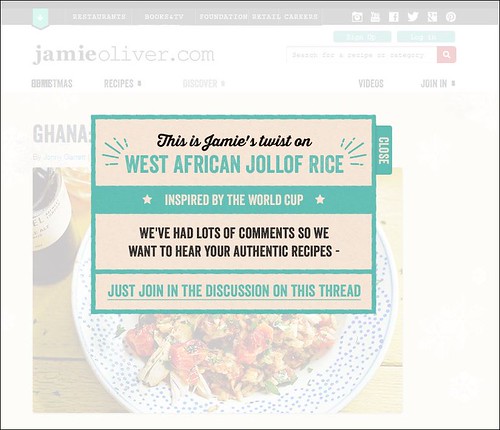
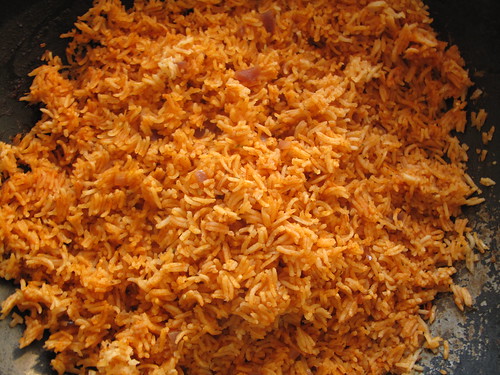



[…] never really given much thought to the perfect drinks for Jollof till #Jollofgate, when I spied a bottle of ale next to Jamie’s offering. Now, I know Jonny Garrett, the […]
Very well said, Oz.
Traditions should be respected, but creativity is allowed. As long as you do not pass it off as the real thing, I’m fine. Jamie is a highly regarded chef, so for him to present his dish to the world as “jollof”, that was upsetting because so many people view him as an authority, and that’s how they meet jollof. Our very special jollof.
However, it’s also worth noting that even with his senrenren, he did not make a three storey pyramid out of his jollof. At a later time, could you talk about the new trends in traditional food presentation that are being advanced? I’m all for creativity, and shaping my rice on a plate. It can be nice. But with African food, Eba is most attractive to me in a perfect ball, anything else isn’t just the same, visually. I’d like to hear your views as a creator.
:). Thank you fellow Butterfly.
Lol, at 3 storey pyramid.
The thing about food is everyone has the way ‘they like it’ and are used to it as well. I think the depth of how much we’ve experienced a thing holds us.
Let me see if thoughts can be gathered and I might write something. Stay well and thanks again.
PS: “curry” doesn’t belong to me any more than jollof belongs to you, or empanadas to the Argentines. My point, in a nutshell 🙂 It’s ingredients, it’s food–play with it! And make it your own in what ways you will. Now, stopping!
🙂
I’ve been away for long but this brings me back. And although it’s truly an annoyance to see dishes called something they no longer remotely resemble, or foods served in ways they’d never be “at home”—to it all I still say: phooey. The fight for authenticity is one of the phoniest ever (yup, irony intentional) and happens at a time when the assertion of such claims is more important than their content. Also, at a time when these so-called “traditions” are mixing and sharing and traveling as never before. It’s a long debate with a long history in political thought so I’ll spare us here 🙂 Suffice to say that, hard though it is at times, annoying though it might be, the sharings and borrowings of all our traditions are also great sources of creative expression, and we should welcome and nurture those possibilities, too. “Tradition,” after all only matters in contexts where we are trying to invent it (dare to call a McChicken sandwich traditional? Oh but it will be, someday, when we’ve forgotten how those things are made, in the same way we valorise foods and ways that are no longer as they once were). Nostalgia is great, but it ain’t my country. Onward, I say!!
So true Deepa, so true.
Onward. Upward
Hi Oz very interesting post there! And very honest of you to mention yr experience with yr Argentinian dish- first of all I do agree thantdishes that come from a region that isn’t ours needs rigorous research- just yesterday I was looking at Jamie’s Oliver s ” shawerma” and you know what – it wasn’t shawerma – I usually laugh things off when I see a taboule that really isn’t one – it happens 99% of the time- but it is a little annoying to see a dish you grew up with and is part of yr culture to be a far cry from what it really is from ingredients, taste and texture- you see it’s the texture – look and smells – is what makes it authentic- it took yr grandmother a life time to get a dish to be where it is- then a chef comes and recreates it with very little resemblance ! So you are right always check with a native eater! Or just say this is a rendition of the dish- your rice looks delicious, with beautiful texture:) and colour- I bet you it was juicy tooxxxxx
Thank you. I think acknowledging the inspiration is key.